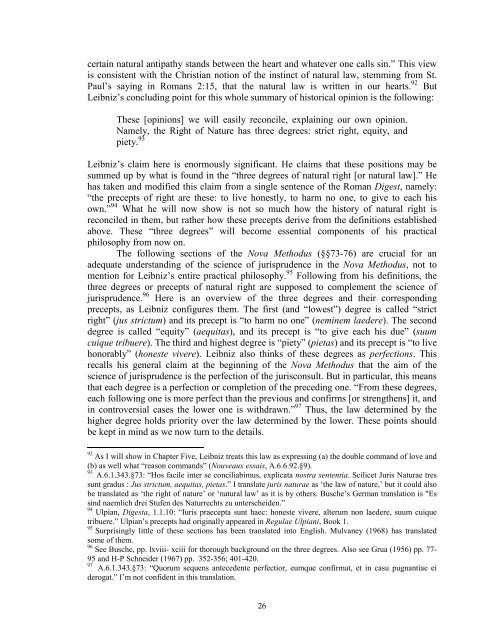Stony Brook University
Stony Brook University
Stony Brook University
You also want an ePaper? Increase the reach of your titles
YUMPU automatically turns print PDFs into web optimized ePapers that Google loves.
certain natural antipathy stands between the heart and whatever one calls sin.” This view<br />
is consistent with the Christian notion of the instinct of natural law, stemming from St.<br />
Paul’s saying in Romans 2:15, that the natural law is written in our hearts. 92 But<br />
Leibniz’s concluding point for this whole summary of historical opinion is the following:<br />
These [opinions] we will easily reconcile, explaining our own opinion.<br />
Namely, the Right of Nature has three degrees: strict right, equity, and<br />
piety. 93<br />
Leibniz’s claim here is enormously significant. He claims that these positions may be<br />
summed up by what is found in the “three degrees of natural right [or natural law].” He<br />
has taken and modified this claim from a single sentence of the Roman Digest, namely:<br />
“the precepts of right are these: to live honestly, to harm no one, to give to each his<br />
own.” 94 What he will now show is not so much how the history of natural right is<br />
reconciled in them, but rather how these precepts derive from the definitions established<br />
above. These “three degrees” will become essential components of his practical<br />
philosophy from now on.<br />
The following sections of the Nova Methodus (§§73-76) are crucial for an<br />
adequate understanding of the science of jurisprudence in the Nova Methodus, not to<br />
mention for Leibniz’s entire practical philosophy. 95 Following from his definitions, the<br />
three degrees or precepts of natural right are supposed to complement the science of<br />
jurisprudence. 96 Here is an overview of the three degrees and their corresponding<br />
precepts, as Leibniz configures them. The first (and “lowest”) degree is called “strict<br />
right” (jus strictum) and its precept is “to harm no one” (neminem laedere). The second<br />
degree is called “equity” (aequitas), and its precept is “to give each his due” (suum<br />
cuique tribuere). The third and highest degree is “piety” (pietas) and its precept is “to live<br />
honorably” (honeste vivere). Leibniz also thinks of these degrees as perfections. This<br />
recalls his general claim at the beginning of the Nova Methodus that the aim of the<br />
science of jurisprudence is the perfection of the jurisconsult. But in particular, this means<br />
that each degree is a perfection or completion of the preceding one. “From these degrees,<br />
each following one is more perfect than the previous and confirms [or strengthens] it, and<br />
in controversial cases the lower one is withdrawn.” 97 Thus, the law determined by the<br />
higher degree holds priority over the law determined by the lower. These points should<br />
be kept in mind as we now turn to the details.<br />
92<br />
As I will show in Chapter Five, Leibniz treats this law as expressing (a) the double command of love and<br />
(b) as well what “reason commands” (Nouveaux essais, A.6.6.92.§9).<br />
93<br />
A.6.1.343.§73: “Hos facile inter se conciliabimus, explicata nostra sententia. Scilicet Juris Naturae tres<br />
sunt gradus : Jus strictum, aequitas, pietas.” I translate juris naturae as ‘the law of nature,’ but it could also<br />
be translated as ‘the right of nature’ or ‘natural law’ as it is by others. Busche’s German translation is "Es<br />
sind naemlich drei Stufen des Naturrechts zu unterscheiden.”<br />
94<br />
Ulpian, Digesta, 1.1.10: “Iuris praecepta sunt haec: honeste vivere, alterum non laedere, suum cuique<br />
tribuere.” Ulpian’s precepts had originally appeared in Regulae Ulpiani, Book 1.<br />
95<br />
Surprisingly little of these sections has been translated into English. Mulvaney (1968) has translated<br />
some of them.<br />
96<br />
See Busche, pp. lxviii- xciii for thorough background on the three degrees. Also see Grua (1956) pp. 77-<br />
95 and H-P Schneider (1967) pp. 352-356; 401-420.<br />
97<br />
A.6.1.343.§73: “Quorum sequens antecedente perfectior, eumque confirmat, et in casu pugnantiae ei<br />
derogat.” I’m not confident in this translation.<br />
26
















